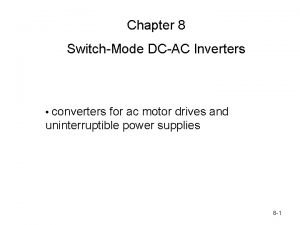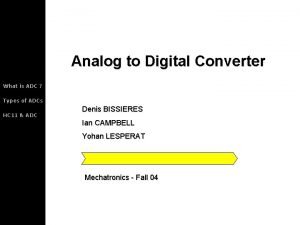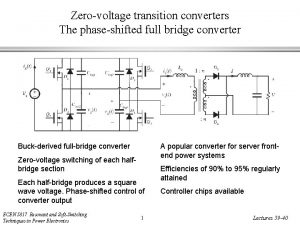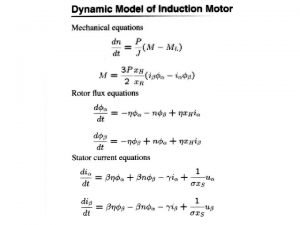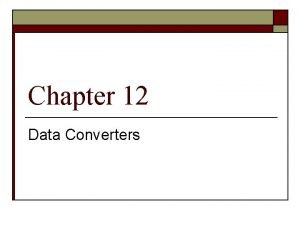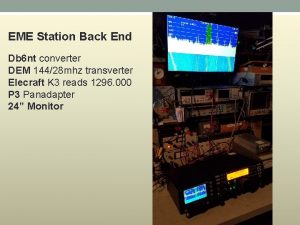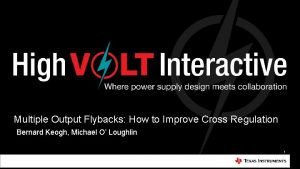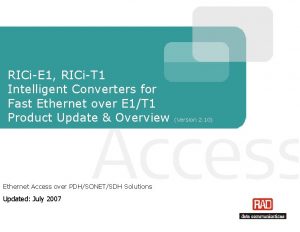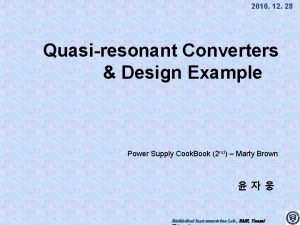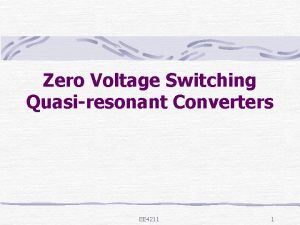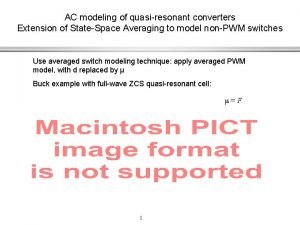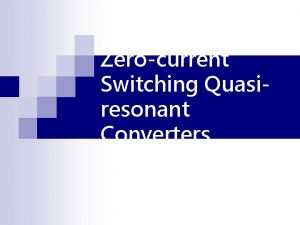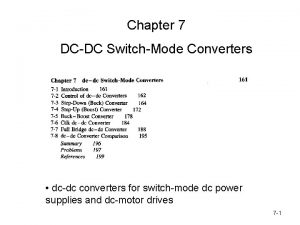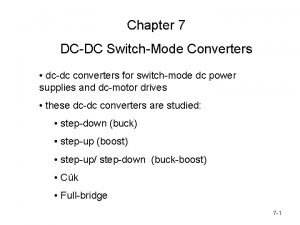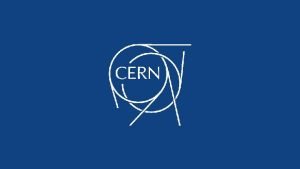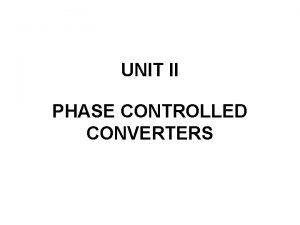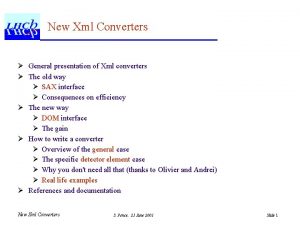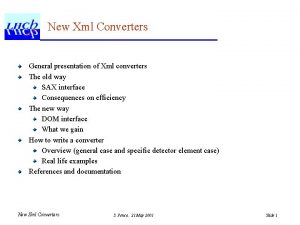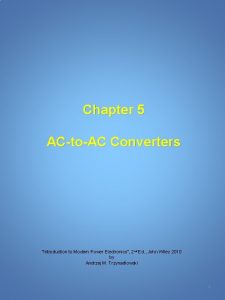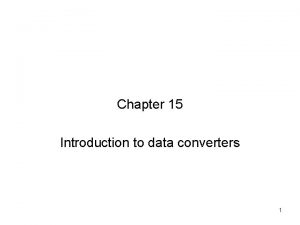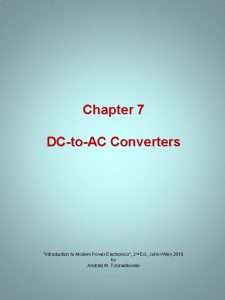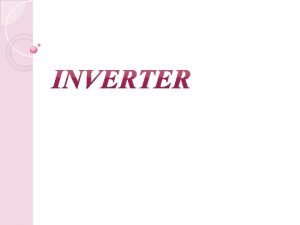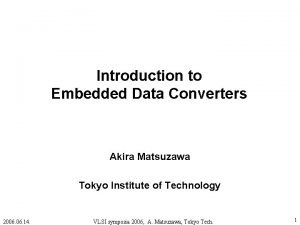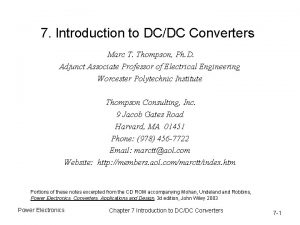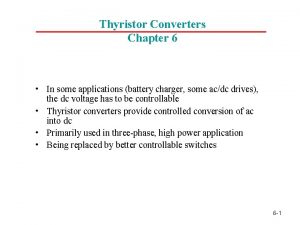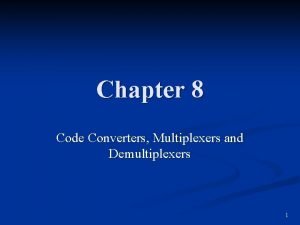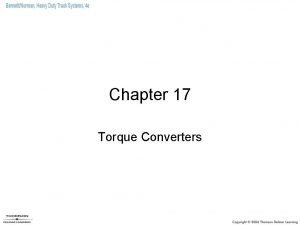Chapter 20 QuasiResonant Converters Introduction 20 1 The




























- Slides: 28

Chapter 20 Quasi-Resonant Converters Introduction 20. 1 The zero-current-switching quasi-resonant switch cell 20. 1. 1 20. 1. 2 20. 1. 3 20. 2 Waveforms of the half-wave ZCS quasi-resonant switch cell The average terminal waveforms The full-wave ZCS quasi-resonant switch cell Resonant switch topologies 20. 2. 1 20. 2. 2 20. 2. 3 The zero-voltage-switching quasi-resonant switch The zero-voltage-switching multiresonant switch Quasi-square-wave resonant switches 20. 3 Ac modeling of quasi-resonant converters 20. 4 Summary of key points Fundamentals of Power Electronics 1 Chapter 20: Quasi-Resonant Converters

Analysis result: switch conversion ratio µ Switch conversion ratio: with This is of the form Fundamentals of Power Electronics 2 Chapter 20: Quasi-Resonant Converters

Characteristics of the half-wave ZCS resonant switch Switch characteristics: Mode boundary: Js ≤ 1 Fundamentals of Power Electronics 3 Chapter 20: Quasi-Resonant Converters


Buck converter containing half-wave ZCS quasi-resonant switch Conversion ratio of the buck converter is (from inductor volt-second balance): For the buck converter, ZCS occurs when Output voltage varies over the range Fundamentals of Power Electronics 5 Chapter 20: Quasi-Resonant Converters


Boost converter example For the boost converter, Half-wave ZCS equations: Fundamentals of Power Electronics 7 Chapter 20: Quasi-Resonant Converters

Fundamentals of Power Electronics 8 Chapter 20: Quasi-Resonant Converters

Fundamentals of Power Electronics 9 Chapter 20: Quasi-Resonant Converters

20. 1. 3 The full-wave ZCS quasi-resonant switch cell Half wave Full wave Fundamentals of Power Electronics 10 Chapter 20: Quasi-Resonant Converters

Fundamentals of Power Electronics 11 Chapter 20: Quasi-Resonant Converters

Analysis: full-wave ZCS Analysis in the full-wave case is nearly the same as in the half-wave case. The second subinterval ends at the second zero crossing of the tank inductor current waveform. The following quantities differ: In either case, µ is given by Fundamentals of Power Electronics 12 Chapter 20: Quasi-Resonant Converters

Full-wave cell: switch conversion ratio µ Full-wave case: P 1 can be approximated as so Fundamentals of Power Electronics 13 Chapter 20: Quasi-Resonant Converters

Half Wave Full Wave

Hard switching at turn-off of diode Conventional buck converter example (Fig. 20. 1) Fundamentals of Power Electronics 15 Chapter 20: Quasi-Resonant Converters

Zero-current switching at turn-off of diode ZVS quasi-resonant buck example (Fig. 20. 2) Fundamentals of Power Electronics 16 Chapter 20: Quasi-Resonant Converters

Zero-voltage switching at turn-off of diode ZVS quasi-squarewave buck example (Fig. 20. 2) Fundamentals of Power Electronics 17 Chapter 20: Quasi-Resonant Converters

Zero-current and zero-voltage switching ZCS quasi-resonant switch: • Tank inductor is in series with switch; hence SW switches at zero current • Tank capacitor is in parallel with diode D 2; hence D 2 switches at zero voltage Discussion • Zero voltage switching of D 2 eliminates switching loss arising from D 2 stored charge. • Zero current switching of SW: device Q 1 and D 1 output capacitances lead to switching loss. In full-wave case, stored charge of diode D 1 leads to switching loss. • Peak transistor current is (1 + Js) Vg/R 0, or more than twice the PWM value. Fundamentals of Power Electronics 18 Chapter 20: Quasi-Resonant Converters

Fundamentals of Power Electronics 19 Chapter 20: Quasi-Resonant Converters

20. 2 Resonant switch topologies Basic ZCS switch cell: SPST switch SW: • Voltage-bidirectional two-quadrant switch for half-wave cell • Current-bidirectional two-quadrant switch for full-wave cell Connection of resonant elements: Can be connected in other ways that preserve high-frequency components of tank waveforms Fundamentals of Power Electronics 20 Chapter 20: Quasi-Resonant Converters

Connection of tank capacitor to two other points at ac ground. This simply changes the dc component of tank capacitor voltage. The ac highfrequency components of the tank waveforms are unchanged. Fundamentals of Power Electronics 21 Chapter 20: Quasi-Resonant Converters

A test to determine the topology of a resonant switch network Replace converter elements by their high-frequency equivalents: • Independent voltage source Vg: short circuit • Filter capacitors: short circuits • Filter inductors: open circuits The resonant switch network remains. If the converter contains a ZCS quasi-resonant switch, then the result of these operations is Fundamentals of Power Electronics 22 Chapter 20: Quasi-Resonant Converters

20. 2. 1 The zero-voltage-switching quasi-resonant switch cell When the previously-described operations are followed, then the converter reduces to A full-wave version based on the PWM buck converter: Fundamentals of Power Electronics 23 Chapter 20: Quasi-Resonant Converters

ZVS quasi-resonant switch cell Switch conversion ratio Tank waveforms half-wave full-wave ZVS boundary A problem with the quasi-resonant ZVS switch cell: peak transistor voltage becomes very large when zero voltage switching is required for a large range of load currents. Fundamentals of Power Electronics 24 Chapter 20: Quasi-Resonant Converters

20. 2. 2 The ZVS multiresonant switch When the previously-described operations are followed, then the converter reduces to A half-wave version based on the PWM buck converter: Fundamentals of Power Electronics 25 Chapter 20: Quasi-Resonant Converters

20. 2. 3 Quasi-square-wave resonant switches ZCS When the previouslydescribed operations are followed, then the converter reduces to ZVS Fundamentals of Power Electronics 26 Chapter 20: Quasi-Resonant Converters

A quasi-square-wave ZCS buck with input filter • The basic ZCS QSW switch cell is restricted to 0 ≤ µ ≤ 0. 5 • Peak transistor current is equal to peak transistor current of PWM cell • Peak transistor voltage is increased • Zero-current switching in all semiconductor devices Fundamentals of Power Electronics 27 Chapter 20: Quasi-Resonant Converters

A quasi-square-wave ZVS buck • The basic ZVS QSW switch cell is restricted to 0. 5 ≤ µ ≤ 1 • Peak transistor voltage is equal to peak transistor voltage of PWM cell • Peak transistor current is increased • Zero-voltage switching in all semiconductor devices Fundamentals of Power Electronics 28 Chapter 20: Quasi-Resonant Converters
 Dcac converters
Dcac converters Whats an adc
Whats an adc Catalytic converter reaction
Catalytic converter reaction Flyback converter
Flyback converter Dcac converters
Dcac converters Digital to analog converters basic concepts
Digital to analog converters basic concepts Eme converters
Eme converters 3 phase dual converter
3 phase dual converter Flybacks
Flybacks Intelligent converters
Intelligent converters Hát kết hợp bộ gõ cơ thể
Hát kết hợp bộ gõ cơ thể Bổ thể
Bổ thể Tỉ lệ cơ thể trẻ em
Tỉ lệ cơ thể trẻ em Chó sói
Chó sói Tư thế worm breton
Tư thế worm breton Chúa yêu trần thế alleluia
Chúa yêu trần thế alleluia Các môn thể thao bắt đầu bằng tiếng đua
Các môn thể thao bắt đầu bằng tiếng đua Thế nào là hệ số cao nhất
Thế nào là hệ số cao nhất Các châu lục và đại dương trên thế giới
Các châu lục và đại dương trên thế giới Công thức tiính động năng
Công thức tiính động năng Trời xanh đây là của chúng ta thể thơ
Trời xanh đây là của chúng ta thể thơ Cách giải mật thư tọa độ
Cách giải mật thư tọa độ 101012 bằng
101012 bằng Phản ứng thế ankan
Phản ứng thế ankan Các châu lục và đại dương trên thế giới
Các châu lục và đại dương trên thế giới Thể thơ truyền thống
Thể thơ truyền thống Quá trình desamine hóa có thể tạo ra
Quá trình desamine hóa có thể tạo ra Một số thể thơ truyền thống
Một số thể thơ truyền thống
